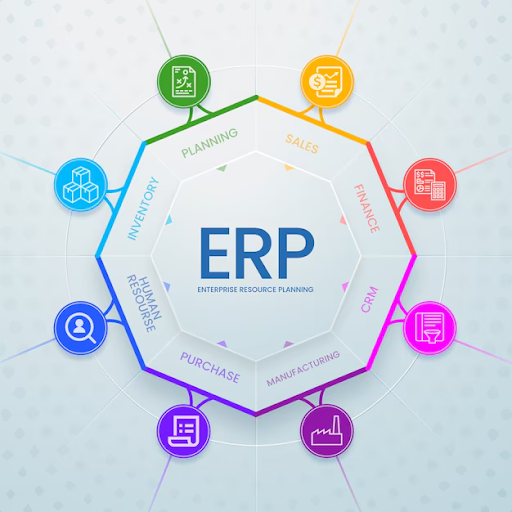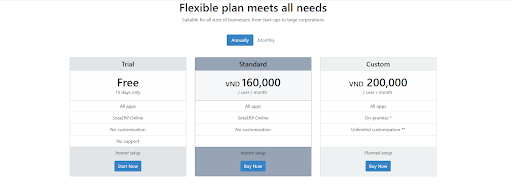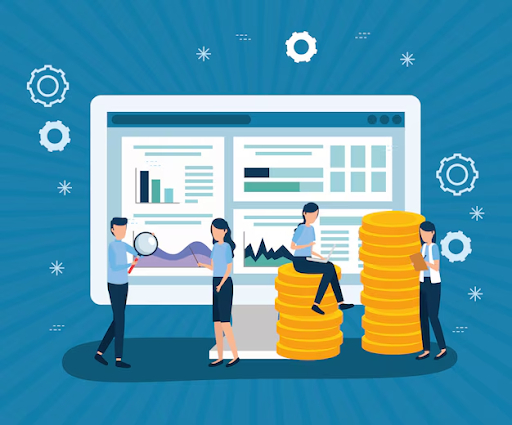Is your business looking for ways to enhance operational efficiency and optimize processes? ERP software (Enterprise Resource Planning) is considered a comprehensive solution for many businesses. However, before deciding to invest in an ERP system, the question arises: How much does ERP implementation cost, and is it truly suitable for your company's budget and scale?
This article will help you better understand the costs of ERP implementation, the influencing factors, and what to keep in mind when implementing ERP to save money, thereby making an informed investment decision.
1. What is ERP?

ERP (Enterprise Resource Planning) is a software system that integrates core business processes such as finance, sales, inventory management, production management, and human resources into a single platform. It allows businesses to monitor and optimize the entire process from start to finish, creating connectivity and automating data.
There are two common types of ERP software:
- On-premise ERP: Higher costs due to the need to invest in hardware infrastructure and on-site maintenance.
- ERP Cloud: Lower cost, no need to invest in hardware infrastructure, easy to scale.
2. What influences ERP implementation costs?

2.1 Size and scale of the business
The size and scale of the business are among the most important factors affecting the total cost of implementing an ERP system. Large enterprises often face higher costs due to the number of users, the complexity of business processes, and high customization requirements. Meanwhile, small and medium-sized enterprises can save costs due to their smaller scale and simpler processes.
2.2 Complexity of business processes
The complexity of business processes is one of the other factors affecting the cost of ERP implementation. The more processes and customizations there are, the higher the implementation costs will be, as they require more time for surveying, analyzing, and understanding. In addition, complex processes will extend the implementation time, leading to increased personnel costs and other project-related expenses.
2.3 Scope of Implementation
The decision to implement the entire ERP system or just certain modules will directly impact the costs. Since the modules operate synchronously, creating a more unified and efficient management system, instead of only implementing certain modules, businesses should consider the scope of ERP implementation in their company.
2.4 ERP Providers
Large, reputable ERP providers often have higher prices due to product quality, support services, and high customization capabilities. However, businesses can be assured of the stability and quality of the software. Businesses need to carefully consider factors such as brand, features, and support services to choose the right partner, helping to optimize costs and achieve the highest efficiency.
2.5 Hardware and software costs
Hardware costs
Physical servers (on-premise) or virtual servers (cloud). Each type has different advantages and disadvantages regarding initial investment costs, operating costs, and scalability. The capacity of RAM, hard drive space, and CPU speed all directly affect the performance of the ERP system and the investment cost. Depending on the scale of the business and the number of users, the business may need more than one server to ensure the system operates stably.
In addition, there are network devices such as switches and routers that ensure the connection between computers and servers, and the cost of network cables depends on the distance and quality of the cables. These factors also affect the total cost.
Software costs
ERP software licenses come in two types: perpetual licenses or subscription licenses. (subscription). The number of users directly using the software will affect the licensing cost. Each module in the ERP software will have a different price. Businesses only need to purchase the modules that suit their usage needs
In addition, supplementary software such as Microsoft Office, Google Workspace, database management software: SQL Server, Oracle, security software: Antivirus, firewall... will also fall within the range of costs that businesses may have to incur.
2.6 Other costs
Consulting and implementation costs
Consulting and implementation costs can account for a significant proportion of the total project cost, depending on the scale, complexity of the system, and accompanying services.
Consulting services help businesses assess current processes, identify weaknesses, and determine the functional and non-functional requirements of the new system. From there, choose the solution that best fits the needs and budget of the business, monitor the project's progress, resolve any arising issues, and ensure the project is completed on time and within budget.
Large, complex projects often require more time and consulting manpower. The scope of consulting services includes activities such as analysis, design, configuration, training, etc. The broader the scope, the higher the cost.
Training costs
Training employees is an indispensable step and plays a crucial role in the implementation process of the ERP system. When employees are thoroughly trained, they will quickly become familiar with the system, master its functions, and make the most of ERP's features. Proficient use of ERP helps employees save time, minimize errors, and increase productivity.
Maintenance and upgrade costs
Maintenance and upgrade costs are regular and ongoing expenses aimed at ensuring the system always operates stably. Specifically, the ERP software needs to be updated regularly to be compatible with new versions of the operating system, database, and other applications. Technical issues are inevitable and need to be addressed promptly to ensure the continuous operation of the system. System maintenance helps ensure information security and prevent external attacks.
3. What does the cost of ERP implementation include?
3.1 Costs License and Modules (Depending on the number of users and the business's usage needs)

Software license fee: This is a one-time fee to obtain the right to use the software. This cost usually depends on the number of users, the number of modules used, and the scale of the business.
Module cost: Each module in the ERP system (e.g., accounting module, production management module, inventory management module...) usually has a different price. The enterprise only needs to pay for the modules it uses.
Suppose a medium-sized manufacturing enterprise with around 200 employees wants to implement SAP ERP to manage production, inventory, finance, and accounting activities. With 200 users and basic modules, the License cost can range from approximately 150,000 to 300,000 USD. The cost for each additional module can range from a few thousand to several tens of thousands of USD, depending on the complexity of the module.
3.2 ERP Customization Fees (Dependent on the level of system customization)
ERP customization fees are costs incurred when a business requests the provider to adjust, supplement, or change the features of the ERP system to fit its specific business processes. The higher the level of customization, the greater the cost.
For example, customizing the interface by changing colors, layout, and logo to align with the company's brand identity. The cost will depend on the complexity of the interface, ranging from a few hundred to several thousand USD.
3.3 Cost of integration with third-party software
The cost of integration with third-party software is an expense incurred when a business wants to connect its ERP system with other software it is using, such as accounting software, CRM, or specialized applications. This integration helps automate processes, minimize errors, and increase the operational efficiency of the business.
3.4 Hosting costs (Data and system storage)
Hosting costs are expenses incurred when a business rents a data storage and ERP system service on a third-party server. This is commonly referred to as cloud ERP.
There are 3 ERP hosting package
Basic package: Usually suitable for small and medium-sized enterprises, with limited storage capacity and bandwidth.
Standard package: Suitable for businesses with average usage needs, offering more features than the basic package.
Enterprise package: Designed for large businesses, requiring high storage capacity and bandwidth, with customizable features as needed.
Types of ERP hosting
Public cloud: Sharing server resources with multiple other customers. Low cost but potentially lower security.
Private cloud: A dedicated server for one customer. Higher cost but higher security.
Hybrid cloud: Combining both forms above, allowing businesses to flexibly choose suitable services.
Suppose a small to medium-sized enterprise with about 50 users wants to rent a basic ERP hosting package. The monthly cost can range from a few hundred to a few thousand dollars, depending on the provider and the selected features.
3.5 Other additional fees
Besides the main costs such as license, module, customization, and hosting that we have mentioned above, there are many other additional fees that may arise during the implementation process.
Common additional costs during the ERP implementation process:
- Consulting fees: This includes initial consulting fees to assess needs, design the system, and consulting fees during the implementation process to address questions and provide technical support.
- Training costs: The cost of training for users so they can effectively use the ERP system.
- Data migration costs: The cost of transferring data from the old system to the new ERP system.
- Maintenance and support costs: This includes system maintenance fees, software updates, and technical support after deployment.
- Upgrade costs: When a new version of the ERP is released, businesses may have to pay a fee to upgrade to the new version.
- Other incidental costs: There may be other incidental costs such as licensing fees, royalties, equipment rental fees, etc.
The cost of ERP implementation can vary depending on each specific project. To obtain an accurate quote, businesses should contact ERP software providers directly.
4. Ways to optimize ERP implementation costs
To save on ERP implementation costs while still achieving high efficiency, businesses can refer to the following methods:
4.1 Choosing the right ERP software
Choosing ERP software that fits the needs and scale of the business is the best way to reduce costs. You should not choose overly complex software if the business only needs basic features.
4.2 Develop a clear implementation plan
A detailed implementation plan helps businesses avoid mistakes and unnecessary costs. This plan should include specific objectives, implementation timelines, and detailed budgets.
4.3 Effective employee training
Good training helps employees quickly familiarize themselves with the system and reduces the time spent on operational errors. This helps reduce error correction costs and optimize work performance.
4.4 Using Cloud ERP
Cloud ERP is a cost-effective option for businesses that do not want to invest in hardware infrastructure. With ERP Cloud, businesses can flexibly scale up and reduce maintenance costs.
4.5 Leverage open-source solutions
Open-source ERP solutions often have low or no costs, helping businesses save on initial budgets. However, it is important to consider the maintenance and technical support costs later on.
5. Compare the implementation costs of the best ERP software available today

Implementation cost of Odoo ERP
For more information: What is Odoo ERP?
Odoo: An open-source ERP solution that is flexible and highly customizable. The cost of implementing Odoo ERP is very difficult to determine accurately from the beginning because it depends on many different factors, including the scale of the business, the number of modules, the complexity of the processes, and the service provider.
Assuming a small to medium-sized shoe manufacturing business wants to implement Odoo to manage production, sales, and accounting. A rough estimate of the potential costs that may arise includes an Odoo license fee estimated at around 1,000 USD/year for a standard package with 5 users, and implementation consulting costs of approximately 5,000 - 10,000 USD for process analysis, system design, and deployment planning. The installation and configuration costs range from approximately 3,000 to 5,000 USD. If module customization is required, the cost can increase by 1,000 USD or more for each customization.
Implementation cost of SAP ERP
The cost of implementing SAP ERP is a frequently asked question but does not have a simple answer, as it depends on many factors. There is no specific number that can be applied to all businesses, because each business has different scales, industries, requirements, and complexities.
The number of SAP ERP modules that a business chooses will directly affect the licensing costs and implementation costs. For example, you are a medium-sized manufacturing company with about 200 employees, wanting to implement the SAP ERP module to manage production, inventory, finance, and accounting. Estimated cost:
- Software license: Approximately 100,000 - 200,000 USD
- Consulting and implementation: Approximately 150,000 - 300,000 USD
- Training: Approximately 50,000 - 100,000 USD
- Hardware and infrastructure: Approximately 50,000 - 100,000 USD
- Total cost: Approximately 350,000 - 700,000 USD
Refer to some other popular and highly-rated ERP software below:
- Oracle: Provides comprehensive ERP solutions for various industries.
- Microsoft Dynamics 365: A flexible and user-friendly cloud ERP solution.
- NetSuite: Suitable for small and medium-sized enterprises, especially those operating in the e-commerce sector.
6. Conclusion
Implementing ERP is an important decision that requires careful consideration of costs. Factors such as the scale of the business, the complexity of the processes, the vendor, and the scope of implementation all directly affect the total cost. Although the initial implementation cost of ERP can be quite high, the long-term benefits it brings are undeniable. ERP helps increase operational efficiency, enhance productivity, minimize errors, and support better decision-making. Therefore, investing in ERP is not just an expense but also a smart investment for the sustainable development of the business. To gain a more comprehensive understanding of the costs and benefits of ERP, please contact us for a free consultation.